Supreme Court Chamber Upholds Life Sentence, Reverses Conviction in Part
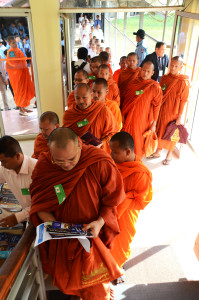
Monks at the entrance of the public gallery (ECCC: Flickr).
On Wednesday morning, the Supreme Court Chamber of the Extraordinary Chambers in the Courts of Cambodia presented their appeal judgment in Case 002/01, in which Khieu Samphan and Nuon Chea stood trial. The Supreme Court Chamber upheld the Trial Chamber’s imposition of life imprisonment for both accused, but partially granted the defense teams’ appeals and reversed some convictions of the two accused.
The much awaited judgment attracted many visitors. The public gallery was attended by diplomats, representatives of governments and media, monks, nuns and the general public. The media room was filled with representatives of a wide range of both international and national radio and TV stations and newspapers. The air was buzzing with excitement about the judgment that was about to be rendered.
At 08:55, the Supreme Court Chamber Greffier announced the internal rules of prohibitions and rules relating to attending the public gallery, such as the prohibition of cheers and laughter and the instruction to dress appropriately.
At 09:06, the judges entered the court room. President of the Supreme Court Chamber, sided by judges Agnieszka Klonowiecka-Milart and Mong Monichariya, announced that the judgment would be heard. All parties were present, as were the two accused. Ten Civil Parties were present in the courtroom: Ms. Sut Ny, Ms. Sou Sotheavy, Mr. Chau Ny, Ms. Kim Hounn, Ms. Sophan Sovany, Ms. Yim Sovann, Ms. Neang Sakhan, Ms. Toeng Sokha, Ms. Seng Sivutha, and Mr. Yin Roum Doul.
Preliminary Matters
On August 07, 2014, the Trial Chamber had rendered its judgment and found the accused guilty of the crimes against humanity of extermination (encompassing murder), persecution on political grounds, and other inhumane acts, including forced transfers, enforced disappearances and attacks against human dignity during three sets of events: Population Movement Phase I (which concerned the evacuation of Phnom Penh immediately after its fall on 17 April 1975), Population Movement Phase II (which related to the population transfers between mid-1975 and 1977) and events happening at Tuol Po Chrey. The Trial Chamber had found both accused criminally responsible for these crimes based on the mode of liability of a Joint Criminal Enterprise, and because they had planned, instigated, aided and abetted the crimes (and in case of Nuon Chea ordered the crimes). The Trial Chamber sentenced both accused to life imprisonment and granted in part moral and collective reparations in eleven projects. Both defense teams, as well as the Co-Prosecutors had appealed the decision. The Nuon Chea entered 223 grounds of appeal, while the Khieu Samphan Defense Team appealed on 148 grounds. The president announced that both appeals would be considered together as they overlapped in part. The appeal by the Office of the Co-Prosecutors (OCP) would be judged upon separately.
Consideration of the Appeals by the Khieu Samphan and Nuon Chea Defense Team
Supreme Court Chamber President Kong Srim pointed out that only those points that were “particularly contentious” and those that were “of particular interest for the public” would be summarized today and grouped into five thematic categories: Fairness of the proceedings, the Trial Chamber’s approach to evidence, the findings relevant to the crimes for which the accused were convicted, individual criminal responsibility, and sentencing.
1 Fairness of the Proceedings
A central point of the Defense Teams’ appeals were the allegation that the accused’s right to fairness of the proceedings had been infringed. This included the categories of the right to an independent an impartial tribunal and the right to an effective defense.
Right to an Independent and Impartial Tribunal
The accused had alleged that their right to an independent and impartial tribunal was violated. Judge Kong Srim announced that the Supreme Court Chamber was not convinced that the Trial Chamber’s bias was shown by “erroneous and illogical findings.” Neither comments made by Judge Cartwright nor by Investigating Judge Marcel Lemonde convinced the Supreme Court Chamber that the Trial Chamber lacked independence.
He then turned to a long-standing and much discussed issue, namely the refusal of the Trial Chamber to call Heng Samrin. The Nuon Chea defense team had repeatedly requested the calling of this important political figure. Thet Sambath (an author and film maker) had alleged that certain witnesses were not called due to security concerns, which the Chamber labelled as “serious allegations”, but considered as “unrelated to the question of whether the Trial Chamber lacked independence.” In equal terms, the Supreme Court Chamber said that “it is not obvious that [a lack of independence] could be the only possible conclusion” of the failure to call Heng Samrin.
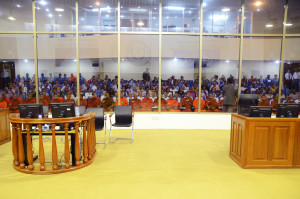
A view from the courtroom to the public gallery (ECCC: Flickr).
Right to an Effective Defense
The refusal to summons Heng Samrin was also relevant for another ground of appeal: it was claimed that the right to an effective defense was impeached. Three of the five Trial Chamber judges had claimed that calling Heng Samrin would cause a “considerable delay” and that he should therefore not be called. The Supreme Court Chamber deemed this the refusal to consider his calling unreasonable, as there was no indication on the record that he would not appear if called. Moreover, the witness had been requested from early stages in the proceedings onwards. The Supreme Court Chamber reached the same conclusion in relation to Ouk Bunchhoeun. Nevertheless, the Supreme Court Chamber deemed that this did not prejudice the accused, as “neither of the two witnesses appeared to have exonerating information that other witnesses did not have.” The unreasonable decision not to consider calling the two witnesses therefore “did not result in a grossly unfair outcome warranting an overturning of the decision.”
The Supreme Court Chamber rejected the defense teams allegations that the internal rules were unconstitutional with regards to the fairness of proceedings (see full judgment).
2 Trial Chamber’s Approach to Evidence
Both defense teams challenged the validity of the Trial Chamber’s approach to evidence. Their grounds of appeal can be grouped into four categories.
Limitation of Investigations at Trial
The accused alleged that they were unduly restricted in their investigations at trial, as the Trial Chamber had said that the defense was not entitled to investigate. The Supreme Court Chamber said that although fully fledged investigations were not envisaged, there was no reason for prohibiting the defense from conducting their own investigations. This would, in particular, allow the defense to make requests. This being said, the Supreme Court Chamber did not find any unreasonableness in the disposal of requests for investigative
Permitting Witnesses to Review Prior Statements and to Confirm their Contents
With regards to the allegation that allowing witnesses to review prior statements, the Supreme Court Chamber said that it “would have been more consistent with Cambodian practice not to adopt this procedure”, but that it did not find that the Trial Chamber abused its discretion in this regard.
Admission of Written Statements in Lieu of Oral Statements
President Kong Srim pointed out that the right to confront witnesses was not absolute. The written statements were admissible, even if the defense cannot investigates. 1,124 written statements and transcripts had been admitted. The Trial Chamber had stated that they took the principle of given lower weight into consideration, which was therefore not a legitimate ground of appeal.
Reliance on Civil Party Evidence
The Supreme Court Chamber was not convinced that the Trial Chamber’s approach to evidence was erroneous by relying on Civil Party statements. The Civil Parties could testify and the weight given to their statements was assessed on a case by case basis. Moreover their Victim Impact
3 Findings Relevant to the Crimes for Which the Accused Were Convicted
The Supreme Court Chamber divided the criminal responsibility into two categories: first, whether these crimes were committed, and second, whether the accused could be legally held responsible for them. He then proceeded to examine each alleged crime for each crime site.
Murder
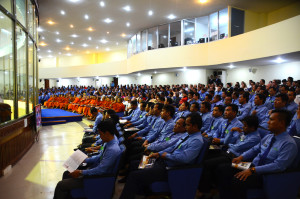
Public gallery (ECCC: Flickr).
The Trial Chamber had defined that the mental element of murder included direct intent, but also dolus eventualis. The Supreme Court Chamber found that the Trial Chamber did not err by including this form of recklessness under the mens rea of murder. As for the factual findings, it had to be established beyond reasonable doubt that individual killings took place. The Supreme Court Chamber found that while some individual findings of murder were not reasonably established, a sufficient number of killings were reasonably established during the evacuation of Phnom Penh and at Tuol Pro Chrey. Thus, it was ruled that the crime against humanity of murder took place.
Extermination
In contrast to the definition of murder, the Supreme Court Chamber rejected the Trial Chamber’s decision to include dolus eventualis in the mental element. For extermination to be committed, there needed to be direct intent. Thus, the Trial Chamber was in part incorrect. The Supreme Court Chamber rejected the accused’s argument that there was no evidence that the mortality rate during the evacuation exceeded the normal mortality rate. However, it was unreasonable to conclude, according to the Supreme Court Chamber, that the mass element of extermination had been established in relation to Phnom Penh, as an only relatively small number may be considered to establish beyond doubt. Hence, there no evidence to establish mass extermination during the evacuation of Phnom Penh. Neither could the Supreme Court Chamber establish the crime against humanity of extermination during Population Movement Phase II. The Trial Chamber had therefore erred in this regard.
However, as the Supreme Court Chamber had found sufficient evidence for murder, they entered a conviction on this basis.
As for Tuol Po Chrey, the Supreme Court Chamber announced that they were not persuaded by the accused’s argument that it had not sufficiently been established that at least 250 soldiers were killed. There was “no doubt that they acted with direct intent to kill on a large scale”, and therefore amounted to extermination.
Other Inhumane Acts
The Trial Chamber had defined the elements of forced transfer and enforced disappearances as if they were separate issues, while they should have held a nature similar to other recognized crimes against humanity. This needed to be analyzed on a case-by-case analysis. The findings on the circumstances during Population Movement Phase I by the Trial Chamber were overall reasonable, but in parts unreasonable, Judge Srim stated. The accused “merely present an alternative interpretation of the events”, and were short of establishing unreasonableness by the Trial Chamber. The Supreme Court Chamber therefore rejected the ground of appeal.
As for Population Movement Phase II, the Chamber found that certain findings of the Trial Chamber “were unreasonable, since they were based on an evidentiary evidence”, but that in general a lack of food, hygiene, and access to medicine and medical assistance was present. Moreover, there was sufficient evidence that some people disappeared and died because of the conditions of the transfers. However, it was unreasonable to find that the “overwhelming majority” of the people in Phase II were New People, as also Old People were transferred.
The Supreme Court Chamber found that the conditions during Population Movement Phase I and II amounted to the crime against humanity of other inhumane acts. These conditions included, amongst others, causing “serious mental conditions”, separating families, poor conditions in relation to food and health.
Persecution
The Supreme Court Chamber found that the Trial Chamber had not erred in its definition of persecution. They announced that the group of New People were sufficiently discernible and rejected the arguments of the accused that New People were not targeted because of their identity during Population Movement Phase I. However, it was determined that the Trial Chamber erred when finding that persecution was committed during Population Movement Phase II, as both New People and Old People were transferred.
The Chamber also dismissed the grounds of appeal relating to the contextual element of crimes against humanity (see full judgment).
4 Individual Criminal Responsibility
Having in part rejected and in part affirmed the existence of crimes, the president then turned to individual criminal responsibility and to the question whether the crimes could be attributed to the accused. The Trial Chamber had found that they were responsible through Joint Criminal Enterprise I and through aiding, abetting and instigating, and in the case of Nuon Chea through superior responsibility.
Joint Criminal Enterprise
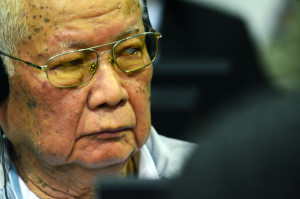
Khieu Samphan (ECCC: Flickr).
The Supreme Court Chamber was not convinced that Joint Criminal Enterprise did not exist as a mode of liability at the time. While the term was only coined later by the work of the ICTY, the notion itself had already emerged in the Post-World-War-II world. The common purpose had to be criminal in character according to this customary international law. However, the Trial Chamber was of the view that crimes that were the result of a common purpose, even if they were not part of plan, were included under the umbrella of JCE I. The Supreme Court Chamber rejected this definition and concluded that it was part of JCE III. There was no basis under customary international law for JCE III at the time, the president said, and it could therefore not adhere to the definition of the Trial Chamber, as the Trial Chamber had committed an error in law.
It therefore needed to be assessed whether the primary objective of the common purpose involved the commission of crimes, which was primarily a question of fact and not law. The common purpose required that it had to be criminal in nature. The implementation of a rapid socialist revolution was not criminal in itself, the president said. However, it “must be seen in the context of policy of population movements and the policy of targeting Lon Nol soldiers”. The Trial Chamber “seems to be lacking in precision”, but a criminal purpose was still established. The Supreme Court Chamber therefore rejected the argument that the purpose was not criminal.
The Supreme Court Chamber did not find errors with regards to the existence and content of a policy of population movement. There was a consistent patterns of evacuation, and the Trial Chamber did not find that all evacuations followed exactly same method of evacuation.
As for crimes encompassed in the purpose of Population Movement Phases I and II, the president announced that the summary would only address the crime of murder, as this was the most controversial issue. The Supreme Court Chamber found that the common purpose encompassed the killings of high-ranking former Lon Nol officials and former soldiers. Moreover, as it was likely that most vulnerable would die and the entire population of the city was forced to evacuate during the hottest season of the year. Moreover, the evacuation was carried out in a very short time span and accompanied by heavily armed groups. This implicitly included purpose that force could be used “should they encounter any resistance”, irrespective of whether any orders to specific killings were given. Hence, the Chamber found it established that the crime of murder existed as part of the common purpose under Population Movement Phase I.
As there was no indication that there was a policy to provide sufficient care or protect the citizens, the occurrence of deaths was likely. Being aware of this, the members of the JCE still engaged in forced transfers.
Existence and Content of the Targeting Policy
Moreover, the Trial Chamber found a policy to kill Lon Nol Officials at Tuol Po Chrey. The Supreme Court Chamber said that the Trial Chamber had emphasized the killing at Udong pre 1975, but the Supreme Court Chamber found that the “evidence was too weak to support such finding.” As for the evidence of killings in the period immediately before and after the events at Tuol Po Chrey, the Supreme Court Chamber deemed the Trial Chamber’s reliance on evidence as “generally weak” except in a few instances. Moreover, with regards to alleged killings in late 1975, the evidence often lacked detail or consisted of uncorroborated court statements. The Supreme Court Chamber was therefore unsatisfied by the findings of Trial Chamber and deemed the evidence as inadequately reasonable that in times before and after Tuol Po Chrey, there had been a policy to kill all Lon Nol soldiers. Further, the Trial Chamber had failed to consider several pieces of evidence that challenged the existence of such a “blanket policy to kill.”
As the scope of Case 002/01 was restricted, as large proportion of evidence was irrelevant, since the Trial Chamber could not demonstrate why instructions in 1976 implied that a policy existed in April 1975.
Thus, the Supreme Court Chamber found that it was unreasonable that a policy with regards to the Lon Nol soldiers and officials existed at the times of the events at Tuol Po Chrey. The accused could therefore not be held criminally responsible for crimes against humanity in that regarded.
The Trial Chamber did not err by taking into account events by accused that were not related prima facie to the crimes.
Contribution by Nuon Chea and Khieu Samphan to the Implementation of the Common Purpose
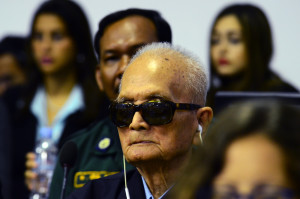
Nuon Chea (ECCC: Flickr).
The president announced that some of the grounds of appeal in relation to his role in planning and role in propagation were dismissed. They reasoned that Nuon Chea offered merely an alternative interpretation. At the same time, the evidence was insufficient to show that Nuon Chea was in charge of the party discipline. Nevertheless, this did not affect the conclusion that Nuon Chea had made significant contribution to the implementation of the common purpose.
As for Khieu Samphan, the Supreme Court Chamber ruled that it was unreasonable to conclude that he attended a meeting in 1074 in which the evacuation of Phnom Penh was discussed. Moreover, a speech of 1976 was erroneously attributed to Khieu Samphan. However, Khieu Samphan’s contribution overall was “not unreasonable” with regards to the totality of the actions (regarding other meetings, his participation in economic matters, public statements in support of the common purpose and acting as a diplomat to gather external support).
Unified Hierarchical Party
The accused had submitted that the Communist Party of Kampuchea was divided into powerful factions and that this meant that they could not be held liable for all actions. The Supreme Court Chamber was not persuaded by this argument, as they were criminally responsible based on JCE. The judge stressed that even if there was a secret plot, this would not mean that the crimes imputed on the accused could not be imputed on the other members of the JCE as well, as long as it has been established that there was a common purpose of which the crimes formed part.
Requisite Intent
The Supreme Court Chamber pointed out that the standard of intent must not be shown for JCE as such, but rather for each crime in itself. Thus, the “direct intent or dolus eventualis” applied to murder (in contrast to extermination that would not allow for dolus eventualis). In case of the death of victims, it was sufficient to establish that the death was a possible consequence of the implementation of the common purpose, as long as the JCE members accepted the possible occurrence of deaths.
Nuon Chea’s and Khieu Samphan’s Intent
As for Nuon Chea’s intent, he himself had admitted his intent to kill “super traitors” and that he had participated in the decision to evacuate Phnom Penh, the president said. Other killings fell under the dolus eventualis due to his knowledge of events during the Population Movement Phases I and II.
In the eyes of the Supreme Court Chamber, Khieu Samphan had failed to substantiate his arguments that he was not aware of the situation due to the “strict principle of secrecy.” Khieu Samphan had also challenged numerous findings relevant to his intent, but failed to establish unreasonableness. However, the Trial Chamber had erred when relying on his attendance of a congress in 1975. Nevertheless, this did not sufficiently call into question the overall conclusion that Khieu Samphan had acted without he requisite intent.
As for other modes of liability, the president informed the parties that it was not necessary to pronounce on these grounds of appeal.
5 Sentencing
Turning to the last segment, the president announced that the Khieu Samphan’s challenge toward the sentencing did not amount to a sufficient challenge of the discretion of the Trial Chamber. The gravity of the crimes should be reflected in the sentence and in a context of a “complete consideration” of the fate of the Cambodian population. It was important to note that the facts were not isolated events but occurred over extended period of time. Thus, the Supreme Court Chamber ruled that the imposition of the life sentence to each of the accused was appropriate and therefore confirmed the sentence imposed on the accused.
Dismissal of the Appeal by the Co-Prosecutors
Judge Srim informed the parties and the public that the Co-Prosecutors had admitted that the appeal had no bearing on the accused’s conviction. As an appeal must allege errors of law that would invalidate the decision, the Co-Prosecutor’s appeal was deemed inadmissible. He noted, however, that the appeals raised by the two accused had given opportunity to examine the notion of JCE and its applicability.
Disposition
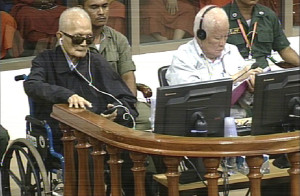
Nuon Chea (left) and Khieu Samphan (right) during the disposition.
The president then announced that Nuon Chea’s and Khieu Samphan’s appeals were in part granted and in part dismissed.
Regarding Population Movement Phase I, it reversed the conviction for the crime against humanity of extermination, and affirmed their conviction for crimes against humanity of murder, persecution on political grounds and other inhumane acts.
Regarding Population Movement Phase II, it reversed the convictions with regards to the crimes against humanity of extermination and persecution of political grounds, but affirmed the convictions for the crime against humanity of other inhumane acts, re-characterizing the facts and entered a conviction for the crime against humanity of murder.
Regarding Tuol Po Chrey, it reversed the convictions for the crimes against humanity of extermination, murder and persecution political grounds, affirmed the sentence of life imprisonment issued to both accused, dismissed the Co-Prosecutor’s appeal as inadmissible and ordered that the accused remain in custody of ECCC until the transfer had been finalized.
At around 10:30 am, the pronouncement of the Appeal Judgment came to a conclusion and the visitors slowly left the public gallery.
Featured Image: Supreme Court Chamber Judges enter the courtroom (ECCC: Flickr).

[…] received mainly praise today, but some criticism of the judgment could also be heard (click here for a summary of the […]